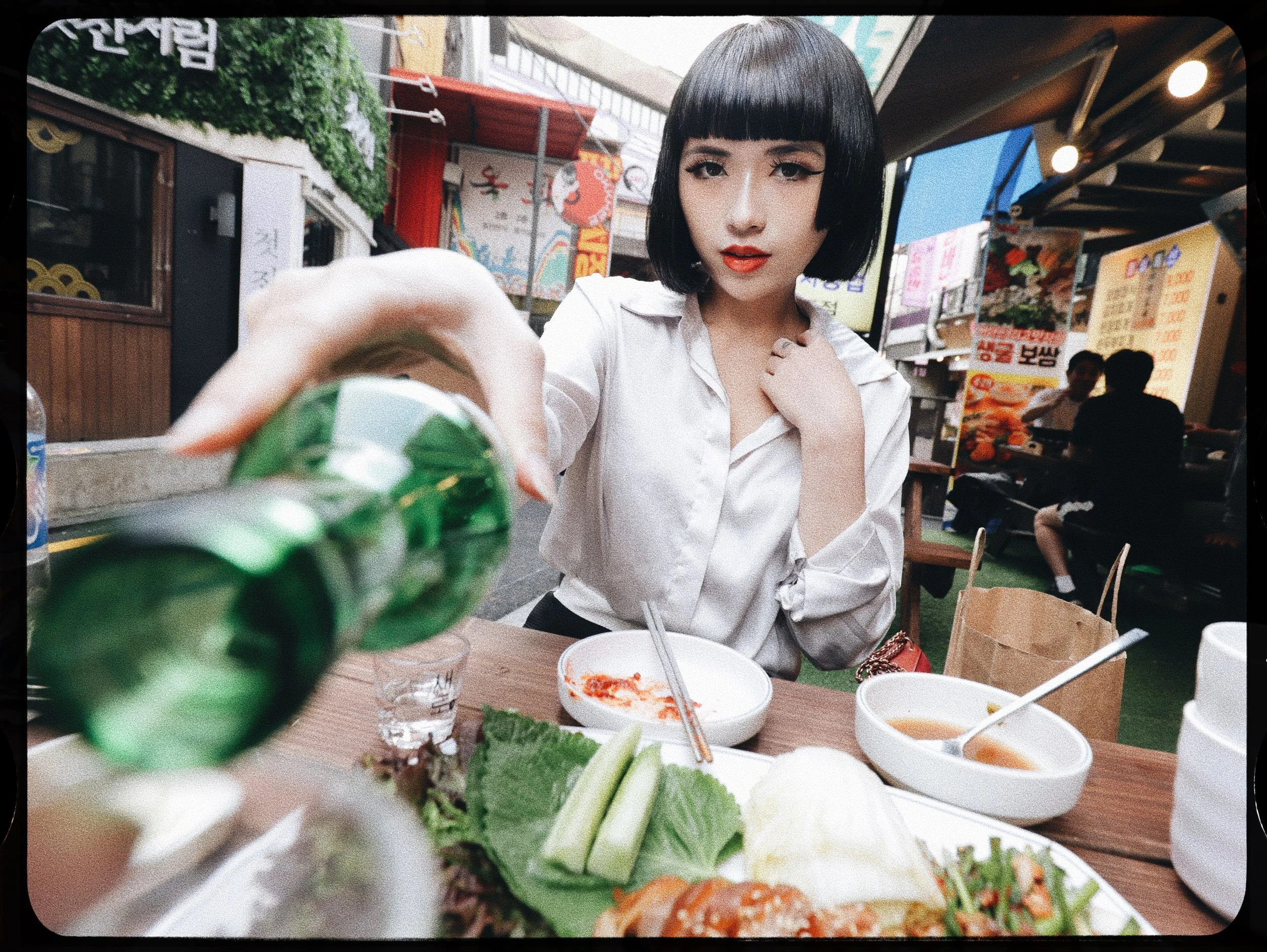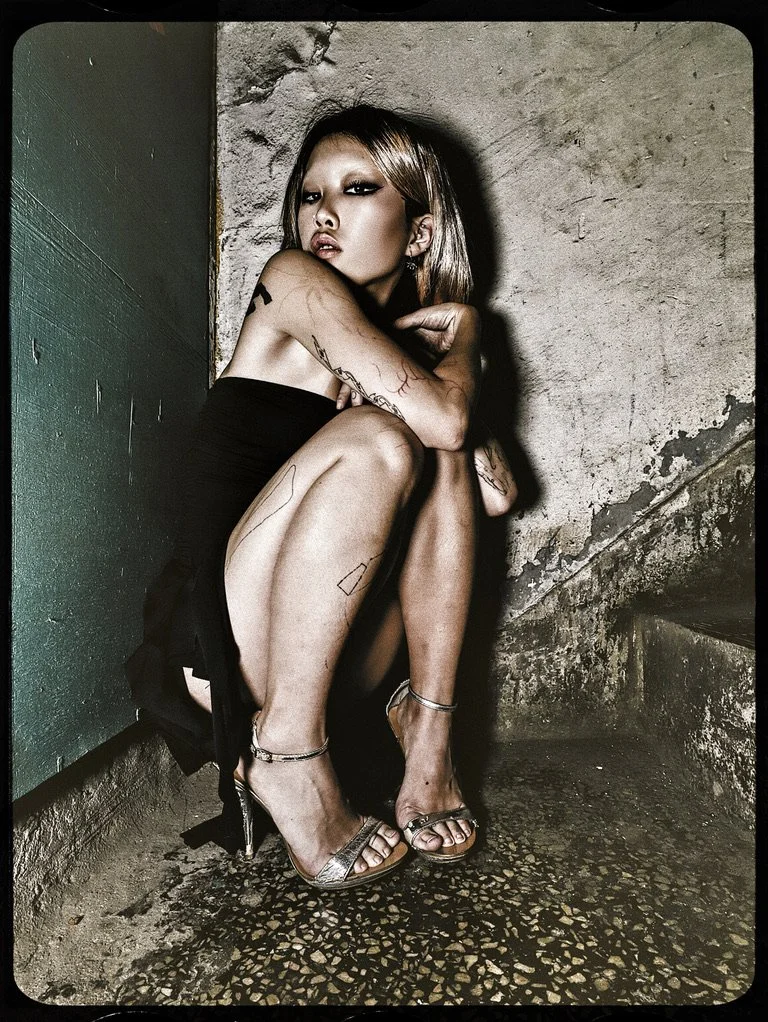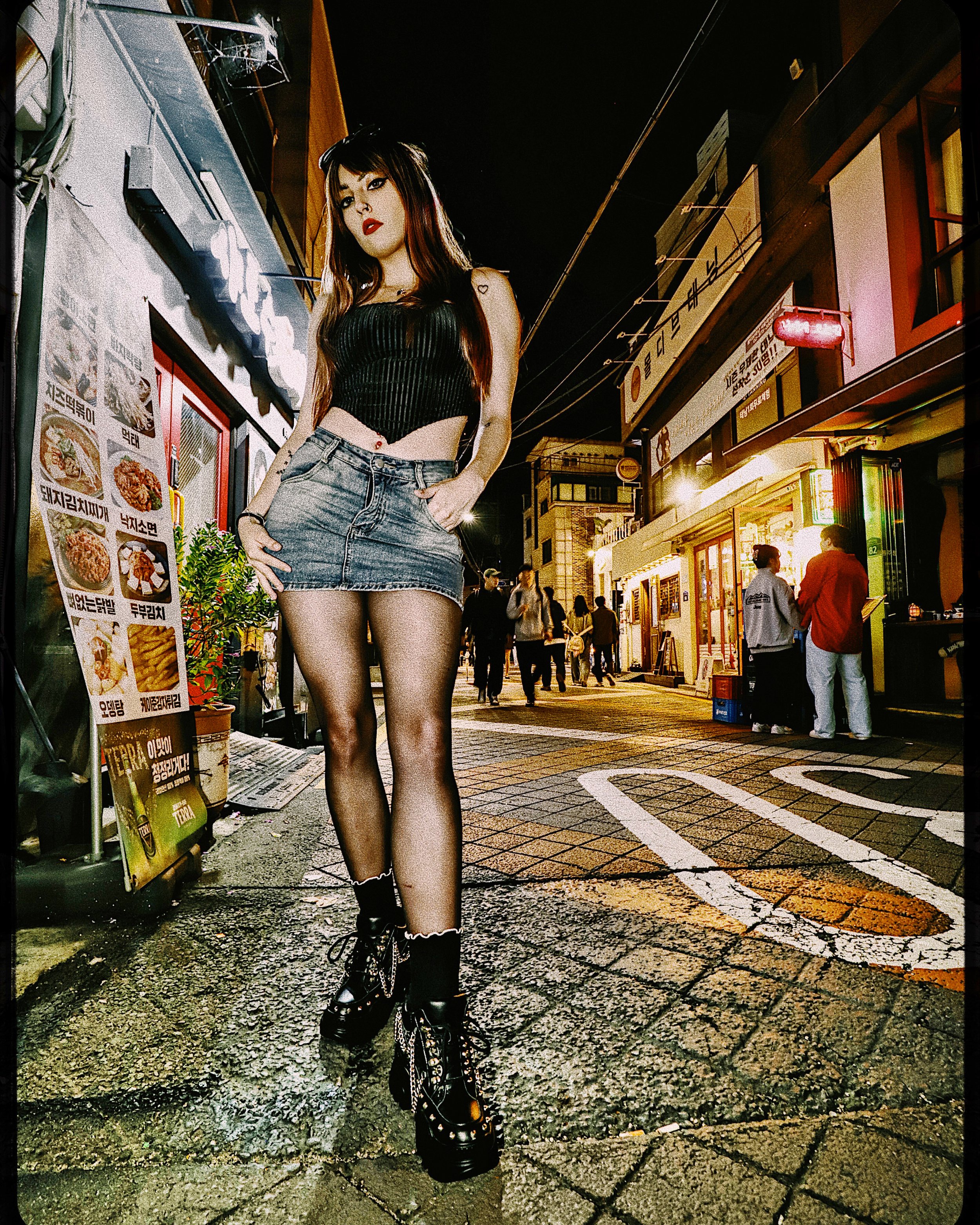“SEOUL Shootouts” with Seoul Street Studios: Project Statement
Korean model @w.ofear smokes wherever she likes in a vintage dress bought at @k2ithkarma.
This project will define a new kind of dynamic and engaging podcast that isn't boring and stuck within a medium of delivery. But rather, it's going to be a dynamic mix of still pictures, interviews, audio,, and on-site, video experiences. The idea will be to anchor the conversation, and all the media production for the episode, within a single neighborhood of Seoul that also anchors the conversation in a specific topic, such as gentrification or something relevant to that space in the city. Thereby, a casual viewer can really get to know a specific area of Seoul, and also over the span of the series, get to know the city. The major content types are delineated as discrete slides following this one. The format and delivery vehicle of the show will be on YouTube, and should be considered a sort of video magazine in that it has a specific, repeating type of content, to be offered on a monthly basis.
본 프로젝트는 딜리버리 매체의 틀에 갇히지 않은 지루하고 불편한 팟캐스트의 새로운 종류를 정의할 것이다. 이 팟캐스트는 정지 사진, 인터뷰, 오디오, 현지 영상 체험 등을 다이나믹하게 결합하여 제공된다. 이 아이디어는 단일 서울 동네에 대화와 에피소드를 기반으로 한 미디어 제작을 정중앙에 두고, 서울의 특정한 주제인 젠트리피케이션 또는 도시 내의 그 공간과 연관된 주제 중 한 가지를 근거로 한다. 이를 통해 일반 시청자들은 특정 지역에 대해 깊이 알 수 있을 뿐만 아니라 시리즈를 통해 도시를 알아갈 수 있다. 이 프로젝트의 주요 컨텐츠 유형은 다음 슬라이드에서 세분화되어 제시된다. 이 쇼의 형식과 방송 매체는 YouTube를 통해 제공되며, 월간 기준으로 특정 반복적인 컨텐츠를 가진 비디오 매거진으로 간주되어야 한다.
Singaporean model @jingruus shows the view how to enjoy Korean drinking culture from a first-person perspective.
As the first large-scale fashion ethnography project conducted in Seoul, we want to map the fashion culture of Seoul in tandem with its signature cultural landscapes, with a tentative list of neighborhoods such as Mullae, Shillim, Hanggandaero (and the environs of the BTS Building), Guro, Itaewon, Euljiro, Haebangchon, Hongdae/Yeonnam-dong, Yongsan/Yongnidan, and Yeoljeongdo.
서울에서 첫 번째 대규모 패션 인류학 프로젝트로 진행되는 이번 연구에서는 서울의 패션 문화를 전통적인 문화적 풍경과 함께 매핑하고자 합니다. 이를 위해 Mullae, Shillim, Hanggandaero (및 BTS 건물 주변), Guro, Itaewon, Euljiro, Haebangchon, Hongdae/Yeonnam-dong, Yongsan/Yongnidan 및 Yeoljeongdo와 같은 동네를 잠정적으로 리스트업하고 있습니다.
Kazhak model @diwine.im enjoys the selfie photo culture that has sprung up in the quickly-gentrifying neighborhood of Mullae-dong.
We will take two angles of analytical attack, across two axes -- one geographic and the other cultural. Whether it be describing the cultural landscapes of discrete neighborhoods such as Shinchon, Hongdae, or Myeongdong, our empirical data gathered as audio interviews, photographs, and other forms of media that will be presented shared in combined form through new media tools such as YouTube, Soundcloud, Facebook, Instagram, and the like, creating a searchable and shareable database of data as an invaluable store of ethnographic data taht will allow people to see the patterns made visible in the complex matrix of South Korean society. We hope that through our efforts at gathering together the raw ethnographic materiél for those without easy personal, social, or physical access to certain ethnographic subjects directly will help in the generation of finished works of cultural/social analysis, while encouraging deeper research into the rich cultures in the megacity of Seoul and its environs.
저희는 총 두 가지의 분석적 접근 방식을 사용할 것입니다. 한 가지는 지리적이고 다른 한 가지는 문화적인 축을 따를 것입니다. 이러한 분석적 접근 방식은 여러 지역으로 확장될 것이며, 예를 들어 신촌, 홍대, 명동과 같은 구역들의 문화적 풍경을 설명함으로써 구체화될 것입니다. 이러한 분석 접근 방식에서는 음성 인터뷰, 사진 및 기타 미디어 형태로 모은 실증적인 데이터를 이용할 것이며, 이러한 데이터는 YouTube, Soundcloud, Facebook, Instagram과 같은 새로운 미디어 도구를 통해 조합된 형태로 공유 및 제공될 것입니다. 이러한 데이터베이스는 검색 가능하고 공유 가능한 형태로 구성될 것이며, 한국 사회의 복잡한 매트릭스 속에서 보이는 패턴을 시각적으로 확인할 수 있는 소중한 민족학적 데이터의 저장소 역할을 할 것입니다. 저희는 개인적이거나 사회적인, 물리적인 접근이 쉽지 않은 사람들을 위해 원천 민족학적 자료를 모으기 위한 노력을 통해 문화 및 사회 분석의 완성작을 만들어내는 데 도움이 되는 것뿐만 아니라, 서울 및 그 주변 지역의 풍부한 문화 연구를 장려하는 것이 우리의 희망입니다.
“CHUSEOK” with model @nabijenn in Mullae-dong.
One of the project’s sub-themes is “Women and the City: Heroine Chic in Seoul.”
프로젝트의 서브 테마 중 하나는 "여성과 도시: 서울의 히로인 시크"입니다.
Model @nabijenn channels the Shillim Girl to perfection.
The very landscape of Seoul is constructed and constituted by young women with disposable income and hypermodern notions of identity. These new foundations of belonging are a leveling force that shatter older, archaic categories of being that brought with them strict rules and limitations, such as in the category of Korean or woman or student. In the 1920s, 1960s, or even the 1980s, there were things that women simply couldn’t do. There were ways of thinking that anyone who called themselves “Korean” were supposed to follow. If you were a high school student, dating was not on your dance card, and you simply didn’t see yourself as possessed of any rights, as someone entitled to anything.
서울의 매우 풍경은 처분 가능한 소득과 하이퍼모던한 정체성 개념을 가진 젊은 여성들에 의해 구축되고 형성됩니다. 이러한 새로운 소속의 기반은 과거의 구식이며 낡은 한국인 혹은 여성 또는 학생과 같은 엄격한 규칙과 제한들을 깨트리는 평준화적인 힘입니다. 1920년대, 1960년대, 심지어 1980년대에는 여성들이 간단히 할 수 없던 일들이 있었습니다. "한국인"이라고 부르는 사람들이 따라야 했던 생각하는 방식들이 있었습니다. 고등학생이라면, 데이트는 당신의 댄스 카드에 없었고, 자신에게 어떤 권리도 없다고 생각하고 있지 않았습니다.
Model @darklypink becomes the Korean High School, down to the giant corn dog in a Shillim self photo studio.
Nowadays, the prime democratizing force in Korean society isn’t any “democracy” itself, but the idea of rights as a consumer. “I bought this seat in a coffee shop, so I can do what I want in it” seems to be what defines public comportment now, as opposed to when it was considered uncouth to do private things in public spaces, like applying makeup in the subway or eating while walking. Or for women to smoke. Or sport tattoos.
요즘 대한민국 사회에서는 "민주주의" 자체보다는 소비자의 권리에 대한 개념이 주요한 민주화 요인입니다. "나는 이 커피숍에서 좌석을 샀으니까 내가 원하는 대로 할 수 있다"라는 말이 공공의 예의를 규정하는 요소로 보입니다. 그와는 달리 예전에는 지하철에서 화장을 하거나 걸어다니면서 음식을 먹는 것과 같은 개인적인 일을 공공 장소에서 하는 것이 거리낌이 있었거나 여성이 담배를 피우거나 문신을 하는 것도 그랬습니다.
Korean model @w.ofear shows her textured skin in a Mullaee-dong stairway.
The Confucian notion that one’s body belongs to one’s parents is over. Now, it’s my body, my choice. In Korea, it’s really women who lead the decision-making on aesthetic matters, and it is aesthetics that lead all consumptive behavior in Korea, from cars to coffee shops.
s한국의 예술에 관한 결정은 여자들이 주도하는 것이 사실이며, 따라서 내 몸은 나의 것이며 내가 선택권을 가진다는 것은, 곧 한국의 문화에서는, 부모님의 몸에 대한 유언과 같은 유언이 존재하지 않음을 의미합니다. 그리고 한국에서는, 자동차부터 커피숍에 이르기까지, 모든 소비 행동을 미적 요소가 주도합니다.
Spanish model @yu.jin.san shows us the colors of “Sharosu-gil” near Seoul National University.
Photographically, I shoot low and aim high, aiming to capture culture from the ground up while looking up to my subjects. As to why women are seemingly the right way of making visual sense of the city, it is best to quote photographer Hein-Kuhn OH quoting art critic Jee-sook BECK in saying that “women are both the subject and object of desire.” I humbly add to this by saying that women are at the same time subject, object, as well as the verb of desire, as it is through women’s aesthetic and consumptive choices that the very cultural landscape of Seoul is now forged.
사진적으로 말해, 저는 낮은 위치에서 촬영하고 높은 곳을 목표로 삼아 지상에서부터 문화를 포착하려고 합니다. 도시의 시각적인 의미를 만드는 데 여성이 가장 적합하다는 이유에 대해서는, 사진작가 오희근이 미술 비평가 백지숙을 인용하여 "여성은 욕망의 대상이자 주체"라고 말한 것이 가장 잘 설명합니다. 저는 겸손하게 여기에 더해 여성은 동시에 주체, 대상, 그리고 욕망의 동사이기도 하다고 말하고 싶습니다. 여성의 미적인 선택과 소비 선택을 통해 서울의 문화적 풍경이 형성되었다는 점입니다.
Korean model @9minuite assumes the superhero pose as Seoul Fashion Week in September, 2023.
Inquire about the project or JOIN US to model, crew, and otherwise participate by contacting us at Instagram @SeoulStreetStudios!!!
프로젝트에 관한 문의사항이 있으시다면, 모델, 스텝 또는 다른 방법으로 참여하고 싶으시다면, Instagram의 @SeoulStreetStudios로 연락해주세요!!!








